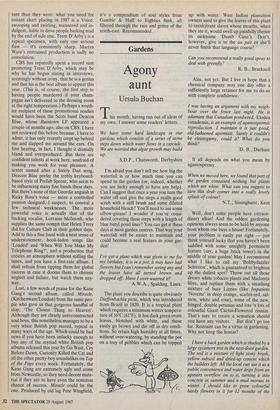Gardens
Agony aunt
Ursula Buchan
This month, having run out of ideas of my own, I answer some readers' letters.
We have some hard landscape in our gardens which consists of a series of stone steps down which water flows in a cascade. We are worried that algae growth may build up.
S.D.P., Chatsworth, Derbyshire I'm afraid you don't tell me how big the waterfall is or how much time you can spend in the garden (or, indeed, whether you are lucky enough to have any help). Can I suggest that once a year you turn the water off and give the steps a really good scrub with a stiff brush and some diluted household bleach? You'll need to use some elbow-grease! I wonder if you've consi- dered covering these steps with a length of blue butyl pond liner? You can get it these days at most garden centres. That way your waterfall will be easier to maintain and could become a real feature in your gar- den!
I've got a plant which was given to me for my birthday; it is in a pot; it may have had flowers but I can't remember seeing any and the leaves have all turned brown and dropped off. Have I over-watered it?
A.W.A., Spalding, Lincs.
The plant you describe is quite obviously Dieffenbachia pitta, which was introduced from Brazil in 1820. It is a tropical plant which requires a minimum winter tempera- ture of 16°C (61°F). It has dark green ovate leaves, blotched with white, and these easily go brown and die off in dry condi- tions. So retain high humidity at all times, without over-watering, by standing the pot on a tray of pebbles which can be topped up with water. West Indian plantation owners used to give the leaves of this plant to recalcitrant slaves whose mouths, when they ate it, would swell up painfully (hence its nickname 'Dumb Cane'). Don't, however, give it to the au pair or she'll never finish that language course!
Can you recommend a really good spray to deal with greenfly?
R. B., Bracknell Alas, not yet. But I live in hope that a chemical company may one day offer a sufficiently large retainer for me to do so with complete confidence.
I was having an argument with my neigh- bour over the fence last night. He is adamant that Canadian pondweed, Elodea canadensis, is an example of agamospermic reproduction. I maintain it is just good, old-fashioned apomixis. Surely it couldn't be cleistogamy, could it? What do you think?
D. B., Durham It all depends on what you mean by agamospermy.
When we moved here, we found that part of the garden contained nothing but plants which are white. What can you suggest to turn this drab corner into a really lovely splash of colour?
N.T., Sissinghurst, Kent Well, don't some people have extraor- dinary ideas! And the oddest gardening opinions always seem to be held by anyone from whom one buys a house! Fortunately, your problem is easily put right — just think yourself lucky that you haven't been saddled with some unsightly permanent feature (say, a huge brick tower) in the middle of your garden! May I recommend what I like to call my 'Bobbydazzler Selection', which is guaranteed to brighten up the dullest spot? Throw out all those dreary white tobacco plants and Madonna lilies, and replace them with a smashing mixture of busy Lizzies (like Impatiens Novette' in deep orange, scarlet-red, sal- mon, white and rose), some of the new, fringed, double petunias and lots 'n lots of colourful Giant Cactus-Flowered zinnias. That's sure to create a sensation should you have any visitors. But don't go too far. Restraint can be a virtue in gardening. Why not keep the hostas?
I have a back garden which is shaded by a large sycamore tree in the next-door garden. The soil is a mixture of light stony brash, yellow subsoil and dried-up cement which the builders left. All the local cats use it as a public convenience and water drips from an upstairs overflow on to it, turning it into concrete in summer and a mud morass in winter. I should like to grow colourful hardy flowers in it for 12 months of the year, in a simple, tasteful, harmony of pinks, blues and greys. It should not cost much to plant up, should last without alteration for years and years, and must be labour-saving. What can you suggest?
E. B., Clapham Nothing.
What is the Fibonacci series?
U. B., Northants I could not even begin to guess. Any- way, it is very bad form, even if you haven't received enough letters, to write to your- self. Look it up.
Miss Buchan regrets that she is far too idle to enter into private correspondence.











































 Previous page
Previous page